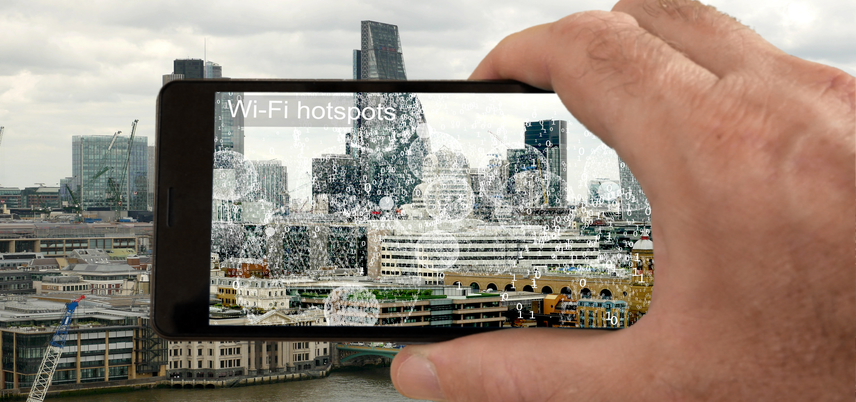Putting the AR in Art with Augmented Reality

Imagine walking down a city street at dusk. To your left is a line of computer code spray-painted on the wall of a building. What is it, if not a piece of hapless graffiti? It’s actually the start of an art installation: Pull out your smartphone, download an app, scan the code and watch it transform into a massive piece of art on the street in front of you.
This isn’t a future scenario. It’s a scene from Paris’ citywide exhibit, Une Journee de Coincidences, where artists display digital versions of art in alleyways and in front of buildings using augmented reality. For this project (which ends September 2017), AR drove the digital transformation of artworks through overlaid digital sound, video and 3D images—all displayed onto physical, real-world environments using viewers’ smartphones as vessels.
As it turns out, the hordes of people gathering at Central Park in search of the ever-elusive Pikachu on mobile game Pokémon Go last year was just the beginning. AR is now used in industries like retail, entertainment and manufacturing—and is increasingly showing up in the world’s art scene, influencing not only artists’ canvases but also audience experience.
AR: The Artist’s Next Great Experiment
Around the world, artists are now experimenting with AR technology to amplify their art—moving from the physical, to the digital, to the augmented.
In a Mexican gallery, Josue Abraham makes static sculptures come to life. Viewers of his stationary record sculpture can hold up a tablet or smartphone to watch the turntable spin and play music; robot arms emerge from walls; and fairies fly around the room.
In New York, Carla Gannis used augmented reality to allow viewers to engage with a daily “selfie” she drew over the course of 52 weeks and published in a digital book format. Her project, The Selfie Drawings, won the 2016 Lumen Prize, an international award for digital art.
“Artists are trying to figure out how to connect art with the digital world, and bridge that gap between physical and digital,” says Lindsay Boyajian, chief marketing officer of Augment, a Paris-based company that sells drag and drop software to artists working to translate their 2D work to AR.
Democratizing Art with Augmented Reality
Augmented reality isn’t just the newest medium, though. It’s also helping art lovers gain access to many existing works.
Los Angeles-based artist Chadwick Gibson recently hosted an AR gallery exhibition that showed virtual images of some of the priciest art in the world—from Picasso to Warhol. Gibson took photos of the well-known pieces, turned those photos into 3D models, uploaded the models to Augment and printed out unique QR codes for the artwork—similar to the way the works are displayed at Une Journee de Coincidences.
“The response has been overwhelming—people literally jump up in the air and clap,” says Gibson. “It’s the democratizing of art and making it more accessible that’s exciting.”
AR can take people deeper into existing museum exhibits, too, says David Lerman, CEO of GuidiGo, which makes software for virtual content in museums. The technology can highlight various points of interest on a painting, for instance, or convey an artist’s backstory or techniques, or tell viewers how the piece was acquired. Museums and galleries, meanwhile, can collect data on visitors, such as how long people spend looking at various works to help determine which collections are chosen in the future.
“This technology will be huge in the future for engagement for the arts,” says Lerman.
The Process of Augmenting Art
AR-ing a museum is no small task, though. The Detroit Institute of Art (DIA) took it on in January 2017. The museum spent six months implementing cloud-based systems to create 3D, virtual experiences for the exhibits on its first floor. There, visitors can access guided directions to objects of interest that are amplified through AR technology. One of the more popular exhibits is an Egyptian mummy: Point a smartphone at it and a 3D animation of the body inside appears, hovering exactly over the mummy’s body.
Though the technology is relatively simple to use, it can still be glitchy, says Andrea Montiel de Shuman, DIA’s digital experience designer. Sometimes the virtual objects float in the middle of the room or they hover two-inches to the left of an exhibit when the museum is too crowded. A room may be too light or too dark and ultimately affect the app’s ability to create the AR experience, too.
Museumgoers, however, seldom notice the glitches. “Visitors don’t care,” Montiel de Shuman says. “They go wild over it. They’re fascinated with it.”
Augmented reality is taking the art world by storm.
Locked Content
Click on the button below to get access
Unlock NowOr sign in to access all content on Comcast Business Community
Resource Center
Learn how Comcast Business can help
keep you ready for what's next.











